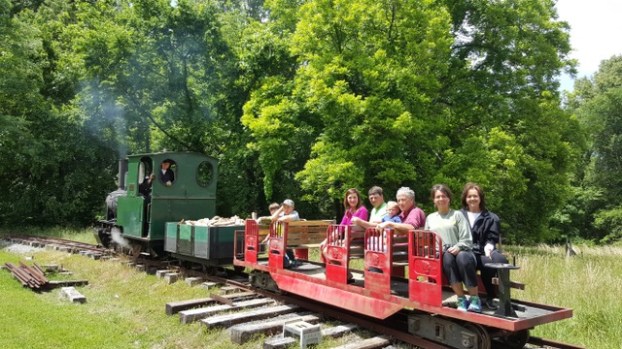These rails will tell no tales
Published 2:37 pm Wednesday, May 7, 2025
By John Nelson
Some recent land clearing south of Highway 6 across from Heafner Motors gave motorists a
better view of a section of raised roadbed of the old Batesville Southwestern Railroad, most
commonly known as the “Dummyline.”
The work also turned up a few pieces of bent and pitted rail sections that somehow escaped
being collected when the rail was taken up in the mid 1930’s. Some friends got them
transported out to my farm where I intend to give them a new life on my Chapeltown Asa
Railroad.
Over the past weeks, a considerable number of hours have been spent straightening the rails,
chipping off years of scale buildup, and using angle grinders to get the 30-foot sections smooth
enough that they won’t wear away the wheels of my two little narrow gauge engines.
Working on them made me think about the stories they could tell if they could talk, for numerous
passengers and tens of thousands of hardwood logs from the virgin forests that once covered
the river bottoms in Panola and Quitman counties have rolled over them. It might have been a
mere 17 miles long and only lasted about 20 years, but the railroad left a lasting imprint on the
history and folklore of southern Panola County.
The railroad was a joint project undertaken by R.J. Darnell, Inc. and the Illinois Central Railroad.
Darnell needed the railroad to get logs to Batesville, and the Illinois Central benefited from the
freight charges to haul them to the Darnell sawmill in Memphis. After the mill in Memphis
burned and was rebuilt in Batesville, the Illinois Central stiff profited by hauling away the finished
lumber products.
The train started the trip to Crowder on the bed still visible behind the Cotton Warehouse (the
old Compress) and consisted of an engine pulling a string of empty log cars with a passenger
coach and baggage car attached to the rear. The train was supposed to depart Batesville at
11:00 AM and begin the return trip from Crowder at 1:00 PM, but since it was operated for the
benefit of the mill and loggers along the route and not for passengers, it was seldom on
schedule.
The first regular stop was where the railroad crossed what is now McDowell Road. The stop
was to be called McDowell until Miss Bessie Cole McDowell sued the line over what she
considered an insufficient payment for the right-of-way and a drainage problem that she claimed
was caused by the roadbed. The railroad then changed the name to Roberson after Jake
Roberson whose house and land was a little further south.
When one turns off Highway 6 onto Crowder Road, passes the old Jarret Faulkner house on the
left, and then rounds the curve and heads southwest, the bed of the old railroad will start to
appear to the left of the road. And as one proceeds up a slight rise before reaching Scot Road,
the railroad cut is plainly visible on the left. From there on, the present road pretty much follows
the old railroad bed to Crowder.
It was around present day Scot Road where my daddy as a young boy would sometimes sneak
down from our farm on the bluff and soap the rails and then hide and watch the locomotive
driving wheels spin. After a few such pranks, the engineer and fireman were prepared at that
spot to sand the rails.
From there, it was a short run down to Asa where Asa Tucker had a large farming operation and
a commissary. Freight was unloaded there for the community and more freight and empty log
cars were dropped off at logging camps that were beginning to appear along the route.
From Asa, the railroad passed over a rough stretch of fill dirt that was frequently washed out by
nearby Asa Creek before arriving at Stone’s Stop where freight and empty cars were left for
logging camps and supplies dropped off for General James Stone’s hunting camp.
Stones’s Stop would give our little railroad a place in literary history since William Faulkner was
a regular there for years. At Stones, there was a lot of drinking and card playing and enough
hunting to give Faulkner the background to write “The Bear,” one of the seven stories that make
up the book “Go Down Moses.” That story even mentions a logging train that carried hunters to
the fictional camp of Major de Spain.
The next stop was Mims, and from there the train rounded a curve and headed due south
passing through Sutton before rolling into Crowder where it was turned around on a wye.
Considerable time was spent in Crowder discharging and loading passengers and freight and
switching log cars before starting the return run to Batesville.
I was a little surprised when underneath the scale the date 1882 appeared as the year the rails
were manufactured – almost 30 years before the first rail was laid on the Batesville &
Southwestern. The rail had been supplied by Illinois Central and had evidently been used
before in another location. I would love to know their earlier history, but these rails ain’t talking.
They’ve been around for over 140 years but the rails are not finished making history. The six
usable lengths I have will extend my railroad 90 feet, and passengers ranging from those
showing up to see a little German locomotive that saw service in WWI to children coming here
to ride Christmas trains will roll over them.
But if the history of their service here is to be preserved, someone will have to record it since
these rails tell no tales.






